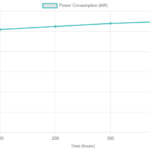As a senior software development specialist in predictive maintenance with AI-based algorithms, I’ll explain how to leverage electricity consumption data to determine the economically optimal peak point for maintaining a specific machine part. The goal is to help machine builders or operators make informed maintenance decisions, minimizing costs while maximizing uptime and efficiency.
Using Electricity Consumption for Predictive Maintenance
Predictive maintenance uses AI algorithms to monitor machine health and predict when maintenance is needed before failures occur. Electricity consumption is a key indicator of machine performance, as it often correlates with the operational efficiency and wear of components. By analyzing patterns in electricity usage, we can identify anomalies or trends that signal when a machine part is nearing a state where maintenance is economically optimal—balancing repair costs, downtime, and energy efficiency.
1. The Role of Electricity Consumption in Machine Health
- Why Electricity Consumption Matters: Components like motors, pumps, or bearings consume more power as they degrade (e.g., due to friction, misalignment, or wear). This increase in energy usage is measurable and often precedes mechanical failure.
- Key Insight: By monitoring electricity consumption over time, we can detect deviations from normal operating patterns, which indicate when a part is under stress or nearing failure.
- Economic Relevance: Maintaining a part too early wastes resources, while waiting too long risks costly failures or inefficient energy use. The „peak point“ is the sweet spot where maintenance minimizes total costs (energy + downtime + repair).
2. AI-Based Algorithm for Predictive Maintenance
An AI-driven predictive maintenance system uses machine learning (ML) models to analyze electricity consumption data and predict the optimal maintenance point.
- Step 1: Data Collection: Install current sensors or smart meters to measure electricity consumption at regular intervals, along with contextual data like operating conditions and maintenance history.
- Step 2: Data Preprocessing: Clean and normalize data, extracting features like average power or consumption trends.
- Step 3: AI Model Development: Use time-series analysis (e.g., LSTM) or anomaly detection (e.g., Isolation Forest) to predict remaining useful life (RUL) based on consumption patterns.
- Step 4: Economic Optimization: Minimize a cost function combining energy, maintenance, and failure costs to find the optimal maintenance time.
- Step 5: Real-Time Monitoring: Deploy the model to trigger alerts when the part approaches the economically optimal maintenance point.
3. Example Scenario: Motor Maintenance
- Normal Operation: A motor consumes 100 kW under typical load.
- Degradation Signal: Bearing wear increases consumption to 110 kW.
- AI Analysis: The model predicts bearing failure within 500 hours of a 10% increase.
- Economic Peak Point: Maintenance after 400 hours minimizes costs (energy: $500, maintenance: $1,000, failure: $5,000).
4. Example Visualization (Chart)
Here’s a chart showing a motor’s power consumption over time with a maintenance threshold:
5. Benefits for Machine Builders
- Enhance machine design with embedded sensors and AI.
- Reduce warranty costs by addressing failures proactively.
- Optimize customer operations with data-driven insights.
6. Conclusion
By leveraging AI to analyze electricity consumption, machine builders can pinpoint the economically optimal maintenance time, improving reliability and customer satisfaction.


